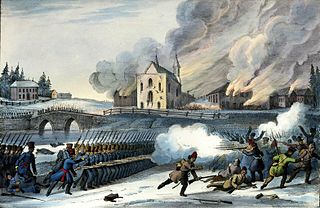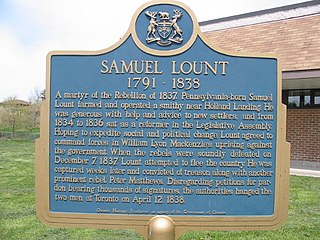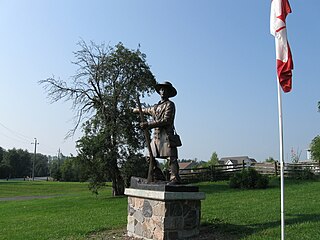
Captain Peter Matthews (1796 - April 12, 1838) was a farmer and soldier who participated in the Upper Canada Rebellion of 1837.

Captain Peter Matthews (1796 - April 12, 1838) was a farmer and soldier who participated in the Upper Canada Rebellion of 1837.
He was born in the Bay of Quinte region of Upper Canada around 1789, the son of Captain Thomas Elmes Matthews and Mary Ruttan, United Empire Loyalists with both Dutch and French (including Huguenot) as well as English ancestry. [1] In 1799, the family moved to Pickering Township. Peter Matthews served with Isaac Brock as a sergeant in the local militia during the War of 1812. In 1837, Matthews was active in the political union movement pressuring the British government to grant reforms, and in December of that year, was persuaded to lead a group from Pickering Township to join William Lyon Mackenzie's uprising. [2]
Matthews' group of 60 men arrived at Montgomery's Tavern on December 6 and, on the following day, were assigned to create a diversion on the bridge over the Don River. They killed one man and set fire to the bridge and some nearby houses before they were driven off by the government forces. [3]
Matthews was arraigned on March 26, 1838 before Sir John Robinson, 1st Baronet, of Toronto after having been held through the winter in jail. He pleaded guilty to treason on the advice of his counsel Robert Baldwin, who provided a less than robust defense given his views on reform. Against the advice of Charles Grant, 1st Baron Glenelg, Robinson and Sir George Arthur, 1st Baronet, as Lieutenant Governor of Upper Canada, wished to set some examples of the rebels, even though the evidence in the case was not clear. [4] Matthews and Samuel Lount were hanged in the courtyard of the new King Street Gaol on April 12, 1838. Joseph Sheard was the foreman for the jail and was expected to share in the work of building the scaffold. However, he refused saying, 'I'll not put a hand to it,' said he; 'Lount and Matthews have done nothing that I might not have done myself, and I'll never help build a gallows to hang them." [5]
He was refused a Christian burial in St. James Cemetery (Toronto) and was instead interred in Toronto's Potter Field (re-developed later into Yorkville, Toronto). [6]
In 1848 Captain Matthews was pardoned and his property was relinquished by the government.

On June 28, 1893 a monument to patriots Captains Peter Matthews and Samuel Lount was unveiled in the Necropolis Cemetery in Toronto. The monument's dedication was led by Canadian Member of Parliament Sir James David Edgar. [7]
In the 1930s a Memorial Arch was placed at the end of the Honeymoon Bridge in Niagara Falls which commemorated the arrival of United Empire Loyalists and those that participated in the Upper Canada Rebellion, included reliefs of Captains Lount and Matthews designed by Emanuel Hahn. These reliefs are now held by the Mackenzie House. [8]
In 1992 the town of Pickering unveiled a plaque for Captain Matthews which read as follows:
Peter Matthews farmed the lands immediately northeast of here in the early nineteenth century. On December 2, 1837, neighbours asked him to lead men from the area to join an uprising against the government in Toronto planned by William Lyon Mackenzie. Matthews supported democratic reforms, was popular in his community, and had served in the War of 1812. He agreed to the request and played a leading role in the confused events of the Rebellion of 1837. When the rebellion failed, Matthews was captured by government militia. Authorities decided to make an example of Matthews and another prominent rebel, Samuel Lount. Convicted of treason and publicly hanged they became martyrs of the rebellion whose memory would be invoked by reformers for generations to come. [9]
In 2012, as part of the 175th anniversary of the executions of Matthews and Lount, a Lount and Matthews Commemoration Committee was formed to raise public awareness. [10]
Captain Matthews had eight children. His son Hiram, who marched with him in the rebellion and was also arrested, was pardoned and remained in Canada (died in Pickering in 1847). His other son, Thomas Matthews, married a Margaret Spencer and migrated to the United States, settling in Worth Township, Michigan. Their farm, believed to have been designed based on Matthews' farm in Pickering, was granted landmark status by the US National Register of Historic Places.

The Province of Upper Canada was a part of British Canada established in 1791 by the Kingdom of Great Britain, to govern the central third of the lands in British North America, formerly part of the Province of Quebec since 1763. Upper Canada included all of modern-day Southern Ontario and all those areas of Northern Ontario in the Pays d'en Haut which had formed part of New France, essentially the watersheds of the Ottawa River or Lakes Huron and Superior, excluding any lands within the watershed of Hudson Bay. The "upper" prefix in the name reflects its geographic position along the Great Lakes, mostly above the headwaters of the Saint Lawrence River, contrasted with Lower Canada to the northeast.

William Lyon Mackenzie was a Scottish Canadian-American journalist and politician. He founded newspapers critical of the Family Compact, a term used to identify elite members of Upper Canada. He represented York County in the Legislative Assembly of Upper Canada and aligned with Reformers. He led the rebels in the Upper Canada Rebellion; after its defeat, he unsuccessfully rallied American support for an invasion of Upper Canada as part of the Patriot War. Although popular for criticising government officials, he failed to implement most of his policy objectives. He is one of the most recognizable Reformers of the early 19th century.

The Upper Canada Rebellion was an insurrection against the oligarchic government of the British colony of Upper Canada in December 1837. While public grievances had existed for years, it was the rebellion in Lower Canada, which started the previous month, that emboldened rebels in Upper Canada to revolt.

Charles Duncombe was a leader in the Upper Canada Rebellion in 1837 and subsequent Patriot War. He was an active Reform politician in the 1830s, and produced several important legislative reports on banking, lunatic asylums, and education.

The Rebellions of 1837–1838, were two armed uprisings that took place in Lower and Upper Canada in 1837 and 1838. Both rebellions were motivated by frustrations with lack of political reform. A key shared goal was responsible government, which was eventually achieved in the incidents' aftermath. The rebellions led directly to Lord Durham's Report on the Affairs of British North America and to the Act of Union 1840 which partially reformed the British provinces into a unitary system and eventually led to the Constitution Act, 1867, which created the contemporary Canadian federation and its government.

Events from the year 1837 in Canada.

Events from the year 1838 in Canada.

The Republic of Canada was a government proclaimed by William Lyon Mackenzie on December 5, 1837. The self-proclaimed government was established on Navy Island in the Niagara River in the latter days of the Upper Canada Rebellion.

The Battle of Montgomery's Tavern was an engagement which took place on December 7, 1837 during the Upper Canada Rebellion. The abortive revolutionary insurrection, inspired by William Lyon Mackenzie, was crushed by British authorities and Canadian volunteer units near John Montgomery's tavern on Yonge Street at Eglinton, north of Toronto.

Samuel Lount was a blacksmith, farmer, magistrate and member of the Legislative Assembly in the province of Upper Canada for Simcoe County from 1834 to 1836. He was an organizer of the failed Upper Canada Rebellion of 1837, for which he was hanged as a traitor. His execution made him a martyr to the Upper Canadian Reform movement.

William Botsford Jarvis was an important member of the Family Compact and Sheriff of the Home District. His estate in what was then York, Upper Canada, gave its name to Rosedale, Toronto. Jarvis Street was named for his cousin, Samuel.

Toronto Necropolis is a non-denominational cemetery in Toronto, Ontario, Canada. It is located on the west side of the Don River valley, to the north of Riverdale Farm in the Cabbagetown neighbourhood.

Enoch Moore was involved in political matters in British North America, and was convicted of high treason and sentenced to hang. His sentence was first commuted to transport to Van Diemen's Land, and then to parole. He eventually returned to, and died in, the United States of America.

The second King Street Gaol was built in 1824 to replace the first King Street Gaol in York, Upper Canada. At that time, the town needed a larger, better constructed jail to replace the original, which was little more than a plain log building with a stockade.
Elias Moore was a Loyalist politician in Upper Canada. Born into a Quaker family in New Jersey just after the American Revolution began, he and his family eventually emigrated to Upper Canada. He later became a member of the Legislative Assembly of Upper Canada, and he is notable for being one of the first Quakers to take an elected seat in Canada.

The Patriot War was a conflict along the Canada–United States border in which bands of raiders attacked the British colony of Upper Canada more than a dozen times between December 1837 and December 1838. It was not a conflict between nations; it was a war of ideas fought by like-minded people against British forces, with the British eventually allying with the US government against the Patriots.

Jesse Lloyd was the founder of Lloydtown, Ontario and a leader in the Upper Canada Rebellion of 1837. Born in Springfield Township, Pennsylvania, he was the third son of Quakers William Lloyd and Susannah Heacock. The Lloyds, who were United Empire Loyalists, possibly came to Canada at Niagara in 1788 but soon returned to the United States. They likely immigrated permanently to Upper Canada in 1808. Upon arrival, they crossed the Niagara gorge and migrated north to settle in the 10th concession of King Township.

Joseph Sheard was an English architect and politician. He was Mayor of Toronto from 1871 to 1872.

The Reform movement in Upper Canada was a political movement in British North America in the mid-19th century.
Samuel Lount is a Canadian drama film, released in 1985.